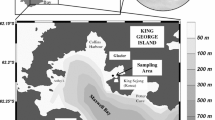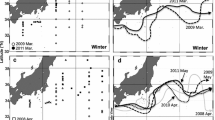Abstract
Size-fractionated primary production was investigated in the Kuroshio Extension (KE) and adjacent regions from winter to spring in order to understand dynamics of spring phytoplankton bloom. Primary production in both the Kuroshio and KE regions was low in winter and ranged from 61 to 185 mg C m−2 day−1, and was composed mostly of small phytoplankton (<10 µm). While large phytoplankton (>10 µm) became major producers in spring with high production of 443–871 mg C m−2 day−1 in the Kuroshio region, the main primary producers remained small in the KE region, and primary production was not elevated as observed in the Kuroshio, ranging from 82 to 492 mg C m−2 day−1. Low production in the KE region in spring was associated with a lack of primary production by large phytoplankton, and this was primarily due to the low availability of nitrate and silicic acid in early spring. Within the KE region, primary production tended to be high in the northern edge and around the axis of the first ridge of the KE meandering compared with other regions of KE. The shoaling of the surface mixed layer produced by intrusion of the southern warmer water was responsible for the high primary productivity.









Similar content being viewed by others
References
Agawin N, Duarte C, Agusti S (2000) Nutrient and temperature control of the contribution of picoplankton to phytoplankton biomass and production. Limnol Oceanogr 45:591–600
Aruga Y, Yokohama Y, Nakanishi M (1968) Primary productivity studies in February-March in the northwestern Pacific off Japan. J Oceanogr Soc Jpn 24:275–280
Barton AD, Pershing AJ, Litchman E, Record NR, Edwards KF, Finkel ZV, Kiorboe T, Ward BA (2013) The biogeography of marine plankton traits. Ecol Lett 16:522–534
Behrenfeld MJ (2010) Abandoning Sverdrup’s critical depth hypothesis on phytoplankton blooms. Ecology 91:977–989
Bower AS (1991) A simple kinematic mechanism for mixing fluid parcels across a meandering jet. J Phys Oceanogr 21:173–180
Brzezinski MA (1985) The Si:C:N ratio of marine diatoms: interspecific variability and the effect of some environmental variables. J Phycol 21:347–357
Chavez FP, Ryan J, Lluch-Cota SE, Niquen CM (2003) From anchovies to sardines and back: multi decadal change in the Pacific Ocean. Science 299:217–221
Egge JK, Aksnes DL (1992) Silicate as regulating nutrient in phytoplankton competition. Mar Ecol Prog Ser 83:281–289
Falkowski PG (1981) Light-shade adaptation and assimilation numbers. J Plankton Res 3:203–216
Hama T, Miyazaki T, Iwakuma Y, Takahashi M, Otsuki A, Ichimura S (1983) Measurement of photosynthetic production of a marine phytoplankton population using a stable 13C isotope. Mar Biol 73:31–36
Hansen HP, Koroleff F (1999) Determination of nutrients. In: Grasshoff K, Kremling K, Ehrhardt M (eds) Methods of seawater analysis, 3rd edn. Wiley-VCH, Weinheim, pp 159–228
Hashimoto S, Shiomoto A (2002) Light utilization efficiency of size-fractionated phytoplankton in the subarctic Pacific, spring and summer 1999: high efficiency of large-sized diatom. J Plankton Res 24:83–87
Ito S, Matsuo Y, Yokouchi K, Inagake D (2000) Cross frontal flow associated with menders of the Kuroshio Extension and distribution of chlorophyll-a. Bull Tohoku Natl Fish Res Inst 63:125–134
Kawai H (1972) Hydrography of the Kuroshio Extension. In: Stommel H, Yoshida K (eds) Kuroshio-Its physical aspects. University of Tokyo Press, Tokyo, pp 235–354
Kimura S, Nakata H, Okazaki Y (2000) Biological production in meso-scale eddies caused by frontal disturbances of the Kuroshio Extension. ICES J Mar Sci 57:133–142
Kondo Y, Takeda S, Nishioka J, Sato M, Saito H, Suzuki K, Furuya K (2013) Growth stimulation and inhibition of natural phytoplankton communities by model organic ligands in the western subarctic Pacific. J Oceanogr 69:97–115
Levitus S (1982) Climatological atlas of the world ocean. NOAA Prof Pap 13, US Govt Print Off, Washington DC
Marañón E, Cermeño P, Latasa M, Tadonléké RD (2012) Temperature, resources, and phytoplankton size structure in the ocean. Limnol Oceanogr 57:1266–1278
Nakata K (1988) Alimentary tract contents and feeding conditions of ocean-caught post larval Japanese sardine, Sardinops melanostictus. Bull Tokai Reg Fish Res Lab 126:11–24
Nakata K (1995) Feeding conditions of Japanese sardine larvae in and near the Kuroshio examined from their gut contents. Bull Natl Res Inst Fish Sci 7:265–275
Nishikawa H, Yasuda I, Itoh S (2011) Impact of winter-to-spring environmental variability along the Kuroshio jet on the recruitment of Japanese sardine (Sradinops melanostictus). Fish Oceanogr 20:570–582
Noto M, Yasuda I (1999) Population decline of the Japanese sardine, Sardinops melanostictus, in relation to sea surface temperature in the Kuroshio Extension. Can J Fish AquatSci 56:973–983
Qiu B, Hacker P, Chen S, Donohue KA, Watts DR, Mitsudera H, Hogg NG, Jayne SR (2006) Observations of the subtropical mode water evolution from the Kuroshio Extension system study. J Phys Oceanogr 36:457–473
Runge JA (1980) Effects of hunger and season on the feeding behavior of Calanus Pacificus. Limnol Oceanogr 25:134–145
Saijo Y, Ichimura S (1960) Primary production in the northwestern Pacific Ocean. J Oceanogr Soc Jpn 16:139–145
Shiomoto A, Tadokoro K, Monaka K, Namba M (1997) Productivity of picophytoplankton compared with that of larger phytoplankton in the subarctic region. J Plankton Res 19:907–916
Shiozaki T, Ito S, Takahashi K, Saito H, Nagata T, Furuya K (2014) Regional variability of factors controlling the onset timing and magnitude of spring algal blooms in the northwestern North Pacific. J Geophys Res C 119:253–265
Suzuki R, Ishimaru T (1990) An improved method for the determination of phytoplankton chlorophyll using N, N-dimethylformamide. J Oceanogr Soc Jpn 46:190–194
Takasugi S, Yasuda I (1993) Temperature indices of the Oyashio front between the Oyashio water and the Tsugaru warm water at 100 m depth in the Iwate coastal region. J Fish Oceanogr Soc Jpn 57:333–344
Townsend DW, Keller MD, Sieracki ME, Ackleson SG (1992) Spring phytoplankton blooms in the absence of vertical water column stratification. Nature 360:59–62
Watanabe Y (2007) Latitudinal variation in the recruitment dynamics of small pelagic fishes in the western North Pacific. J Sea Res 58:46–58
Watanabe Y, Zenitani H, Kimra R (1995) Population decline of the Japanese sardine Sardinops melanostictus owing to recruitment failures. Can J Fish Aquat Sci 52:1609–1616
Yamamoto T, Nishizawa S, Taniguchi A (1998) Formation and retention mechanisms of phytoplankton peak abundance in the Kuroshio front. J Plankton Res 10:1113–1130
Yasuda I (2003) Hydrographic structure and variability in the Kuroshio-Oyashio transition area. J Oceanogr 59:389–402
Yasuda I, Watanabe T (2007) Chlorophyll a variation in the Kuroshio Extension revealed with a mixed-layer tracking float: implication on the long-term change of Pacific saury (Cololabissaira). Fish Oceanogr 16:482–488
Yokouchi K, Tsuda A, Kuwata A, Kasai H, Ichikawa T, Hirota Y, Adachi K, Asanuma I, Ishida H (2007) Simulated in situ measurements of primary production in Japanese Waters. In: Kawahata K, Awaya Y (eds) Global Climate Change and Response of Carbon Cycle in the Equatorial Pacific and Indian Oceans and Adjacent Landmasses. Elsevier, Amsterdam, pp 65–88
Acknowledgments
We thank the captains, crew members and scientists on board the cruises of R/V Wakataka-Maru, Soyo-Maru, Hakuho-Maru, and Tansei-Maru for the cooperation at the sea. We also thank M. Nakamachi and T. Ikeya for chlorophyll a and nutrients data, and K. Hayashizaki for his cooperation in mass spectrometry. This study was financially supported by the grant ‘Studies on Prediction and Application of Fish Species Alternation’ (SUPRFISH) from the Research Development of Agriculture Forestry and Fisheries Research Council, and a MEXT grant (24121005).
Author information
Authors and Affiliations
Corresponding author
Rights and permissions
About this article
Cite this article
Nishibe, Y., Takahashi, K., Shiozaki, T. et al. Size-fractionated primary production in the Kuroshio Extension and adjacent regions in spring. J Oceanogr 71, 27–40 (2015). https://doi.org/10.1007/s10872-014-0258-0
Received:
Revised:
Accepted:
Published:
Issue Date:
DOI: https://doi.org/10.1007/s10872-014-0258-0




